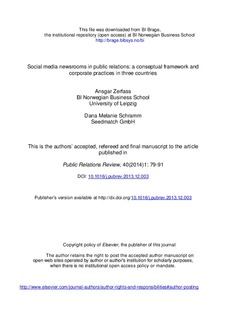Social media newsrooms in public relations: a conseptual framework and corporate practices in three countries
Journal article, Peer reviewed
Permanent lenke
http://hdl.handle.net/11250/277820Utgivelsesdato
2014Metadata
Vis full innførselSamlinger
- Scientific articles [2181]
Sammendrag
The rise of social media in organizational settings has opened up new horizons for strategic
communication. However, there are also drawbacks. Arguably the most important one is
increased complexity. Many communication departments use a multitude of platforms ranging
from corporate websites, campaign microsites and blogs to services like Facebook, Twitter, and
the like to communicate with stakeholders. Social Media Newsrooms (SMNRs) have been
introduced as instruments to reduce this complexity. The basic idea is straightforward: SMNRs
aggregate social media content provided by the organization and/or thematic content about the
organization and its key issues from several platforms in one place. Although SMNRs have been
used in public relations practice around the world since the concept was first introduced in 2007,
empirical evidence is still missing. This paper closes the research gap by a) introducing SMNRs
from a conceptual perspective based on a literature review, b) exploring opportunities and
challenges for strategic communication, c) researching empirical manifestations and modes of
usage by corporations in three major international markets (United States, United Kingdom,
Germany) based on a comprehensive content analysis of the 600 largest companies and 2,045
2
affiliated brands and subsidiaries, and d) explaining implications for the practice of public
relations.
Beskrivelse
This is the authors' accepted and refereed manuscript to the article
